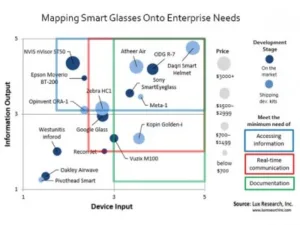Lux Research, the US based Research Institute with a focus on emerging technologies has published a report on the status of smartglasses in enterprise applications. In this research, they have studied more than 70 enterprise deployments of augmented reality hardware and software. Many of these deployments are still in the evaluation or beta test phase, which makes it difficult to evaluate in any other way than through proprietary research. They have to talk to every company and see what they can find out.
Lux focused on what hardware is best used under different circumstances. They identified 16 hardware platforms that can be used in enterprise applications. This is pretty impressive from an overall perspective. However, we have to realize that they included some “not completely released” models and lower end devices like the Recon Instruments Jet, which is more of a specific device aiming at sports enthusiasts. Nevertheless, as the market is coming from the “Google Glass is everything” perspective, it shows that there is more life in the augmented reality market than might be expected.
We have already pointed to the shift in the augmented reality market since Vuzix came out with the M100 headset that was squarely aiming at professional applications. After Google canceled its attempt to address the consumer market with Glass and focus instead on enterprise applications, it became clear that the consumer adoption of AR glasses will have to wait.
 Source: LUX Research
Source: LUX Research
Lux Research compares the hardware platforms by the performance related to device input capabilities and information output. The chart shows the results of their analysis. Any kind of analysis in this kind of approach will require some qualitative comparison that is influenced by the person evaluating the devices. On the positive side, it allows the inclusion of “soft” factors in the evaluation, something that comparing just resolution, field of view and brightness cannot provide. How good the image is may be more important than how many pixels the imager provides. In addition, response times and processing capabilities have to be evaluated taking into consideration the application. There are many more aspects to be considered, making this approach difficult to say the least.
Lux also defines areas where information access, real time communications and documentation are the most important factors for the application. This is a clever approach, however the areas are so large and overlap by so much that approach is somewhat questionable. By their evaluation, Google Glass falls somewhere into the middle of the chart, making it only usable for real time communication (maybe also for accessing information), but it is by no means the best hardware for either use. The Daqri Smart Helmet is their favorite by the described measurements, even though it is only available in development kits today. The best available product is the ODG R7 in this chart.
While this evaluation is by no means perfect, it is very good start to identify strength and weaknesses of AR devices for specific tasks. Something we will see more of, once the enterprise markets start adopting this technology on a wider scale. -NH

